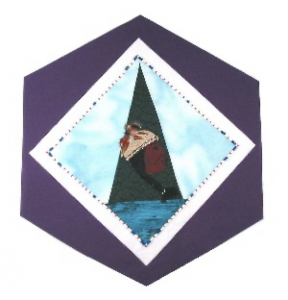Tuscarora

The Block
Julia Stiles Vernon designed and created the Tuscarora block. The green triangle representing the Great Tree of Peace stands above all others against a blue background, symbolizing the sky and the lakes of Tuscarora ancestral territory. A Tuscarora man in profile, wearing the Gahsdo:wa (or Kustowah) hat, with his hair tied and braided in the Tuscarora style, represents the people. The Gahsdo:wa was usually a strip of deerskin wrapped around the head like a turban and decorated with fine, small feathers. The headpiece on the block was made with hemp and decorated with feathers and white glass beads representing traditionally used Whelk shells. The purple background fabric represents the Quahog shells of the Iroquois wampum belt.
Cultural Profile
The Tuscarora call themselves Ska-ru-ren meaning “those of the Indian hemp”, or “hemp gatherers”, or “shirt wearing people”. This name refers to their skills in making hemp shirts. The Tusucarora were divided into the Turtle, Wolf, Beaver, Eel, Bear, Snipe, Sand Turtle and Deer clans. Each person belonged to the clan of his or her mother.
Before the arrival of Europeans, it is estimated that 25,000 Tuscarora peoples were originally located in Virginia and North Carolina. They were a powerful people who shared their knowledge of the land and survival skills with the first white pioneers. This contact cost many Tuscarora their lives. Foreign diseases and territorial conflicts with an ever-increasing influx of European immigrants, resulted in many deaths.
During the Tuscarora Wars of 1711-13, the Tuscarora were displaced from their traditional lands along the Roanoke and Neuse Rivers in a series of clashes with the settlers. They fled north following the White Roots of Peace, extending out from the Great Tree of Peace standing in the territory of the Five Iroquois Nations. They settled near the Oneida and eventually joined the Haudenosaunee Confederacy in 1722, becoming the 6th member. The Tuscaroras became the Keepers of the Eastern Door and are known as the Younger Brothers in the confederacy.
With the outbreak of the American Revolution, most Tuscarora joined the Oneida and supported the colonials against the British. A small number joined the Mohawks in support of the British. Following the British defeat, this group, led by Joseph Brant, moved northward, settling in the Grand River territory in Ontario. Today, about 2,000 Tuscarora live on and off the reserves of Glebe Farm and the Six Nations near Brantford, Ontario. There are also smaller groups living on a reservation near Lewiston, New York, and in Pembroke, North Carolina.
Sponsor: Douglas & Ursula Quantz, in memoriam Ida Quantz
